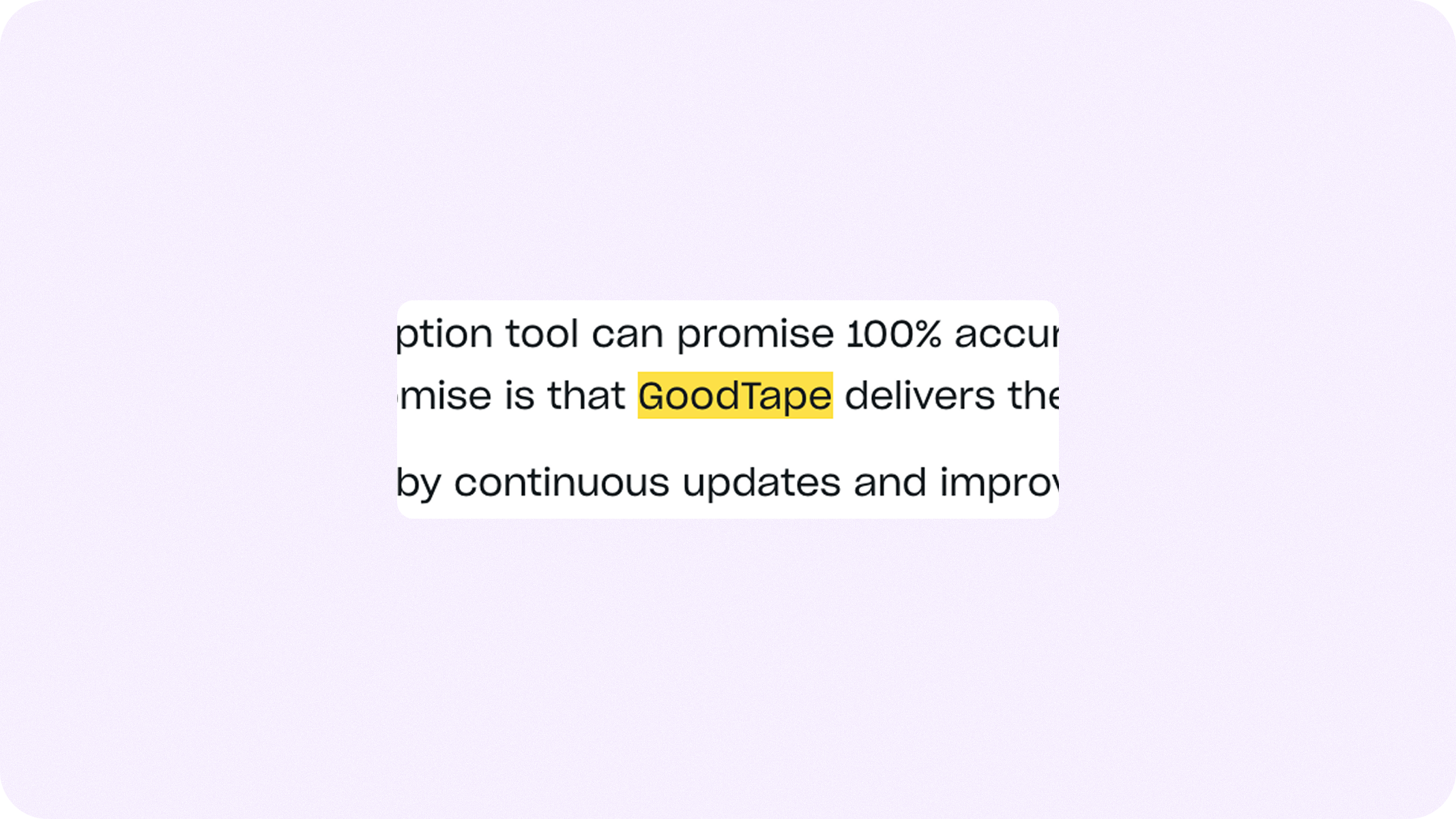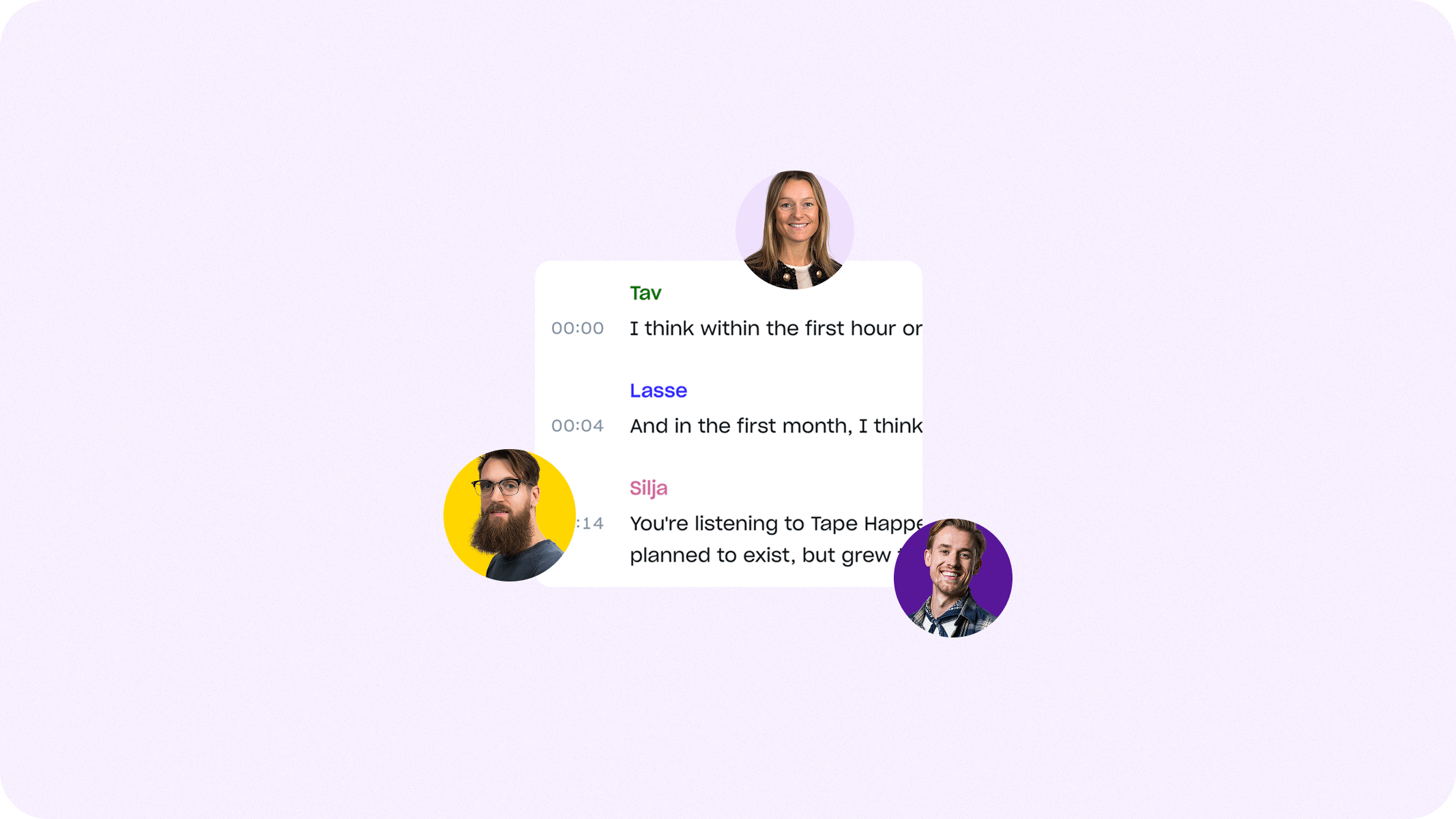Transcribing interviews for qualitative research

Summary
- Transcribing interviews is essential for accurate qualitative research and reliable data analysis.
- It captures tone, pauses, and emotions that help interpret participant intent.
- Qualitative research focuses on understanding why and how not just what or when.
- Accurate transcription supports validity, reliability, and depth in findings.
- Using tools like Good Tape saves hours and ensures secure, GDPR-compliant results in minutes.
Transcribing interviews is an important step in qualitative research, as it forms the backbone of data analysis and interpretation. In other words we can say that it acts as a vital link between those unfiltered conversations and insightful data acquired from them. But why is accurate transcription so crucial in qualitative studies?
The fundamentals of qualitative research itself provide the first justification. The depth with which linguistic expressions and emotions are communicated during interviews is crucial for this kind of research. Accurate transcription ensures that these non-verbal cues are also added for more clarity.
Transcribing interviews qualitative research is essential to ensuring the correctness of findings because it enables researchers to fully capture the range of participant replies and perspectives. Moving forward in this article we have compiled a comprehensive guide to help you get a more clear perspective on how to transcribe interviews for qualitative research.
What Is qualitative research?
Qualitative research is one of the most commonly used research methods in the field of academia. Instead of concentrating just on the what, where, and when of decision-making, it explores the why and how by focusing on the human aspects of a specific issue or situation. It aims to comprehend people’s experiences, actions, feelings, and the interpretations they place on objects.
Getting a much deeper insight into people’s attitudes, actions, value systems, concerns, motives and goals is the main aim of qualitative research. It is employed to acquire a deeper comprehension of intricate occurrences that are challenging to put into numerical form.
The main characteristics of qualitative research are:
- Focus on context: It explores the context in which behaviours and events take place.
- Subjectivity: It recognizes the subjective nature of the study and frequently captures the perspectives of the participants.
- Extensive analysis: This entails a thorough examination of a limited number of case studies or circumstances.
- Inductive approach: The inductive approach often begins with observations and builds theories from them.
- Flexibility in design: As the study goes on, the research question format may change. Here it is not necessary to follow the predetermined context.
Researchers use qualitative interview as their main method of data collection for this research since it allows them to interact with the subject first hand and focus on the non-verbal cues along with the information they are sharing.
Looking for support in transcribing your qualitative research interviews? Good Tape offers transcription services that can help you better understand your interviews. We’re here to help make your transcription process more manageable and efficient. Explore how Good Tape can assist you in your research endeavors.
Qualitative vs quantitative interviews
Qualitative and quantitative interviews are different research approaches, each with a unique strategy for collecting and interpreting data. Quantitative interviews seek to measure human behaviour and experiences in a form that can be statistically examined, whereas qualitative interviews concentrate on investigating and comprehending the depth and complexity of human behaviour and experiences.
While both are extensively used in the field of research, it is important to understand where either of the two should be used. Below is a comparative table of both against which you can determine which of the two would work best in your scenario.
| Aspect | Qualitative Interview | Quantitative Interview |
| Purpose | To understand people’s experiences, ideas, and feelings on a deeper level. | To quantify information and generalise findings to a wider audience. |
| Nature of data collection | Textual, descriptive | Numerical, statistics |
| Data collection method | Open-ended questions and unstructured interviews | Close-ended questions and structured interviews |
| Sample size | Smaller since more focus is on depth of information | Larger since more focus is on statistics and generalisation |
| Approach | Exploratory | Conclusive and factual |
| Outcome | Detailed understanding of a particular problem or area of interest | Quantifiable insights |
| Flexibility | Increased flexibility as questions are adapted according to the situation | Decreased flexibility as questions are predetermined and close-ended |
This table presents a clear contrast between qualitative and quantitative interviews, highlighting the differences in their technique, strategy, and study conclusions. The choice between both majorly depends on the research question at hand and the nature of the topic being studied.
How to transcribe an interview for qualitative research
For qualitative research, transcription of interviews is a painstaking procedure that needs time and close attention to detail. It requires turning spoken words from your recorded audio or video into text.
In qualitative research, this transcribing procedure is essential to data processing. Here’s a step-by-step tutorial on effectively transcribing interviews, along with a few tips to make the process as easy as it can be.
Record clear audio of the interview
Select a peaceful, quiet workstation for your interviews to reduce distractions and improve focus. It is important to have a well-positioned microphone and high-quality headphones if you want to record even the minute details of speech without picking up excessive background noise.
If there are any unpleasant noises in your audio, services like Good Tape can be quite helpful. They are made to carefully pick up on all spoken and nonverbal cues, even in busy settings, and automatically transcribe all your work for you, so you won’t miss any important information.
Transcription you can actually trust
Join millions of users that rely on Good Tape
Work around your transcription
Precise transcription is essential for detailed analysis, accurately recording each word and nonverbal cue. This comprehensive approach allows for a deeper understanding of both the verbal as well as non-verbal cues in communication.
Similarly, intelligent verbatim concentrates on streamlining the text by eliminating unnecessary words and sounds to focus on the primary concepts, resulting in a transcript that is more focused and structured. Revised transcriptions enhance the material by improving clarity and fixing grammar, guaranteeing that the final transcript is accurate, comprehensible, and cohesive.
Audio transcription services such as Good Tape make accurate transcription easy with a shorter turnaround time.
Finalise the transcript
For easy navigation and the identification of important points or sensitive parts within the text, transcript formatting consistency is essential. Consistent formatting facilitates reading and improves the transcript’s overall usefulness.
A further crucial stage is anonymization, which anonymises any confidential or private data to comply with legal regulations. This also gives the interviewees peace of mind knowing that the information they provide will not be used illegally. To ensure that the transcript is correct, well-written, and presented professionally, one last review is necessary to spot any spelling, grammatical, or flow errors.
Some useful tips
Manual transcription can take a lot of time, therefore patience is essential. However, if you wish to have accurate transcripts in less time, using services such as Good Tape can cut down on the amount of time required.
It’s also very important to make sure that your transcribed documents are safe. Maintaining regular backups is essential to avoiding data loss. Using services that automatically store and back up your transcribed audio might be a sensible choice if you find it difficult to remember to do backups, since they provide efficiency and peace of mind.
Why accurate transcription matters in qualitative research
Precise transcription is essential to qualitative research because it supports the accuracy and essence of the whole research process. It is the first stage of data analysis and has a direct impact on the findings and recommendations of the study. There are several reasons why accurate transcribing is important and advantageous.
Impact on data analysis
- Maintains originality: Preserving the original context of spoken words is ensured via precise transcription. For accurate interpretation of the data, this is essential.
- Enables comprehensive study: If the transcription has even minute error, it may prevent researchers from doing a thorough study of the interview data, including discourse, theme, and content analysis. Conversation analysis requires a lot of details which is possible through detailed notes of its accurate transcription.
- Supports accuracy: Data analysis in qualitative research is a very crucial step. More valid findings are produced when transcripts are accurate because they give researchers a solid foundation.
Impact on research outcomes
- Validity of findings: The reliability of the study findings is directly impacted by the quality of the transcribing. Inaccurate conclusions may result from word misinterpretation or omission.
- Reliability and reproducibility: A key component of scientific investigation is replication, which is made possible by accurate transcribing, which also increases the research’s dependability.
- Reflects the voice of the participant: Accurate transcribing preserves the integrity of the participants’ contributions by correctly capturing their voices.
Benefits of accurate transcription
- Enhances credibility: Precisely recorded information strengthens the credibility of the study among other researchers and readers.
- Facilitates peer review and cooperation: Because other researchers can comprehend and analyse the data with clarity, it makes effective peer review and cooperation possible.
- Enhances engagement with data: When data is precisely translated, researchers may interact with it at a deeper level, which results in more perceptive analysis and interpretation.
Accurate transcription plays a crucial role in maintaining the validity, reliability, and integrity of the research findings. It improves the quality and depth of data analysis, guaranteeing that the conclusions are solid, reliable, and accurate representations of the experiences and viewpoints of the participants.
Trusted by professionals and teams at
Want to read more?
Check out these related resources
Help center (FAQ)
What is qualitative research?
Qualitative research focuses on understanding people’s experiences, behaviors, and emotions. It explores the why and how behind actions rather than just the what or when.
Why should I transcribe interviews for qualitative research?
Accurate transcription ensures that every detail, tone, and pause from interviews is captured, allowing for deeper insights and reliable analysis.
How does transcription improve data accuracy?
By converting spoken words into precise text, transcription maintains context and meaning, which strengthens the validity and credibility of research findings.
Is Good Tape free to use?
Yes. Good Tape offers a free plan so anyone can start transcribing without a credit card.
Why should I use Good Tape?
It’s built for accuracy, speed, and simplicity — helping you focus on storytelling instead of manual transcription.
Is Good Tape secure?
Yes. Good Tape provides secure and accurate transcriptions that you can rely on. We are fully GDPR compliant. We will never train on your data. Your data is yours and you remain in control.
Is Good Tape suitable for academic research?
Absolutely. Good Tape is secure, GDPR-compliant, and supports over 100 languages ideal for researchers working with sensitive or multilingual data.
Secure transcription for research interviews
Discover reliable audio to text transcription


